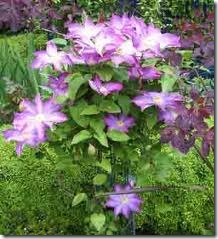Clematis come in more than 50 different species, with even more varieties within each species, according to the U.S. Department of Agriculture. Most of these are woody vines, but some also grow as herbaceous perennials and evergreens. Flower size, color and shape, as well as foliage appearance and overall size, all vary between plants, helping gardeners identify different varieties. Other differences include blooming season and fragrance. Proper identification helps gardeners provide adequate care for clematis, since ideal growing conditions and maintenance vary somewhat between species and varieties.
- Difficulty:
- Moderate
Instructions
- Examine the growth habit of the plant to narrow down the possibilities. Herbaceous perennials grow in bushy forms while most other grow as vines. Most are also deciduous, but the Clematis armandii is an evergreen.
- Compare the size of the plant to the size of different types of other clematis. For example, fast growers such as Clematis montana reach up to 30 feet in height, easily setting it apart from the more common 6- to 10-foot-tall varieties. Examples of these include Clematis alpina, Clematis viticella and hybrids such as Henryi and Barbara Jackson.
- Consider flower size, shape, color and fragrance. Flowers on large-flowered cultivars such as Clematis lanuginosa and Clematis florida reach 4 to 8 inches in diameter while those on other species typically grow to 1 to 3 inches in diameter. These include Clematis tangutica and Clematis chrysocoma. Flower shapes include clusters of white flowers, bell-shaped flowers and flat flowers. Small-flowered varieties offer unique fragrances, such as Clematis armandii with its vanilla scent. Colors range from purple or almost blue to white, yellow and pink.
- Use blooming time to identify possible species. Clematis bloom from early spring to late fall, depending on the location. Clematis macropetala is the earliest bloomer, with other early bloomers including Clematis armandii and Clematis montana. Later bloomers include the small-flowered Clematis maximowicziana and Clematis tangutica. Hybrids bloom once in late spring or early summer, followed by occasional blooming throughout the rest of the growing season.
- Look at the foliage for additional clues as to the clematis species and variety. Clematis foliage shows wide variation, with some common ones easily identifiable by their unusual foliage characteristics. For example, Clematis fremontii, a 20-inch-tall herbaceous perennial, develops thick, leathery leaves early in the growing season. By comparison, Clematis recta has pinkish-purple colored leaves in early spring that only turn green as the season progresses. The foliage on the late-flowering Clematis texensis maintains a bluish color while new foliage on the Clematis chrysocoma is bronze-colored.
Tips & Warnings
-
Pay close attention to whether your clematis flowers in the spring, summer or fall, as this affects the time at which you must prune to avoid cutting off the buds.


Deprecated: strpos(): Passing null to parameter #1 ($haystack) of type string is deprecated in /home/agriviek8Qv/agriviet.net/public_html/wp-includes/comment-template.php on line 2522